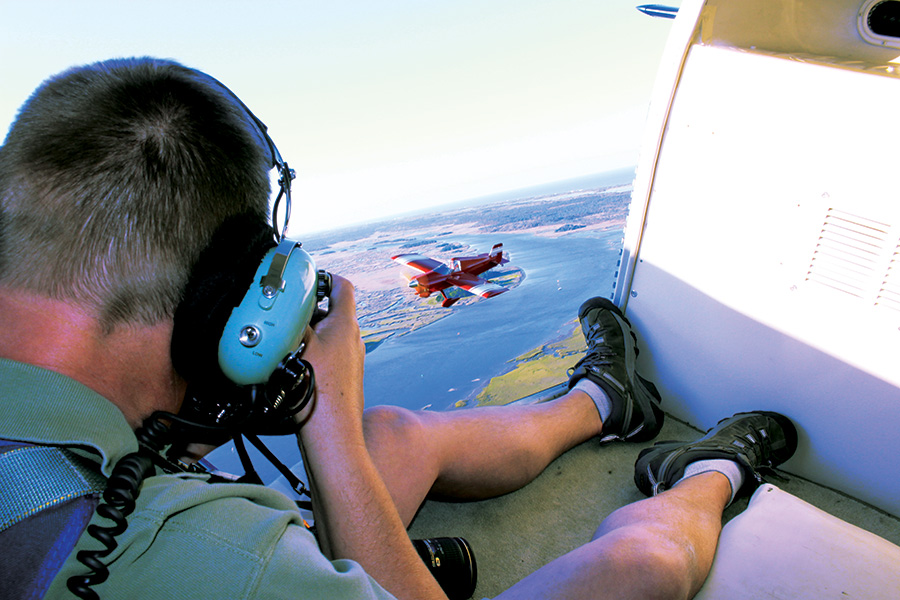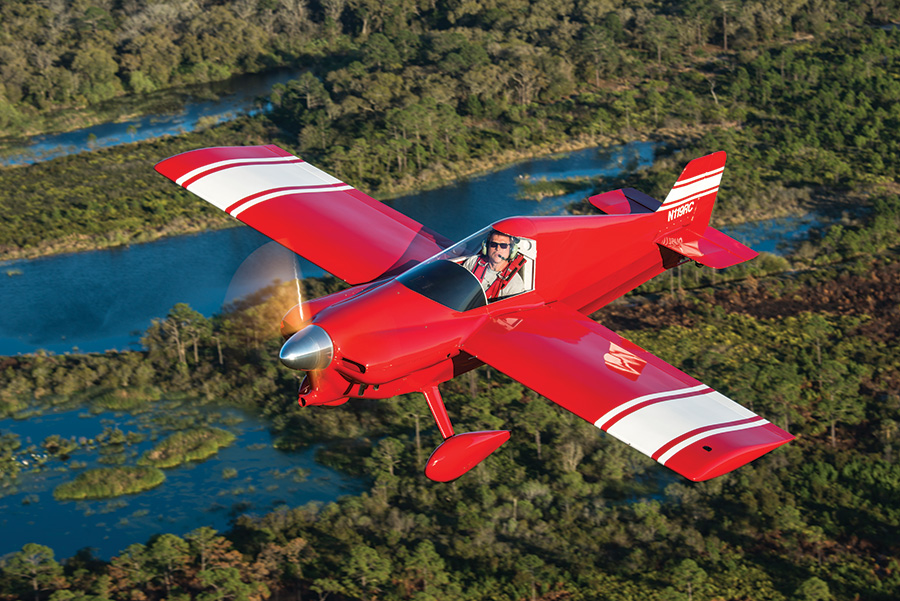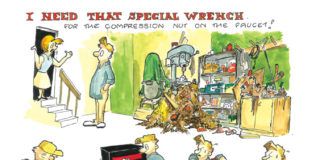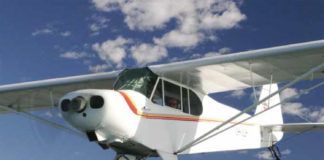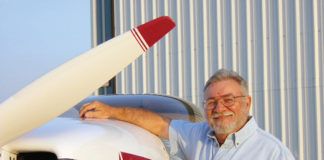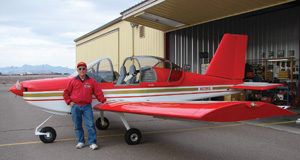It’s late morning, and I’m at 9500 feet near Tallahassee, on my way to school. As the magazine’s new guy, I can’t afford to miss a learning opportunity, so when I heard professional air-to-air photographer Richard VanderMeulen would be in Florida to shoot features for KITPLANES® during Sun ‘n Fun week, I cleverly proposed a “reader ride-along” article. Editor Paul Dye gave his blessing, VanderMeulen agreed to a temporary apprentice, and now I’m southbound in my RV-8. It’s a beautiful day, warm and bright blue, with a brisk wind at my back. Hmm…the XM says windsocks are popping smartly all along the coast. I wonder if it will calm down this evening?
Arriving at George Baker Aviation in New Smyrna Beach, I find Beechcraft expert Curtis Boulware removing the rear doors and most of the club seating from his faithful A-36 Bonanza. Boulware is one of VanderMeulen’s regular photo ship pilots. Chatting about the upcoming photo mission, I learn that the A-36 is a favorite air-to-air platform, with a wide speed range and an excellent field of view. Although not strictly required, removing the seats will allow VanderMeulen to sit on the floor and move about the door opening.
The annual New Smyrna Balloon and Skyfest is going on as we prepare. Patti Wagstaff is making her turnarounds overhead, followed by the AeroShell T-6 team. Boy, this is fun!
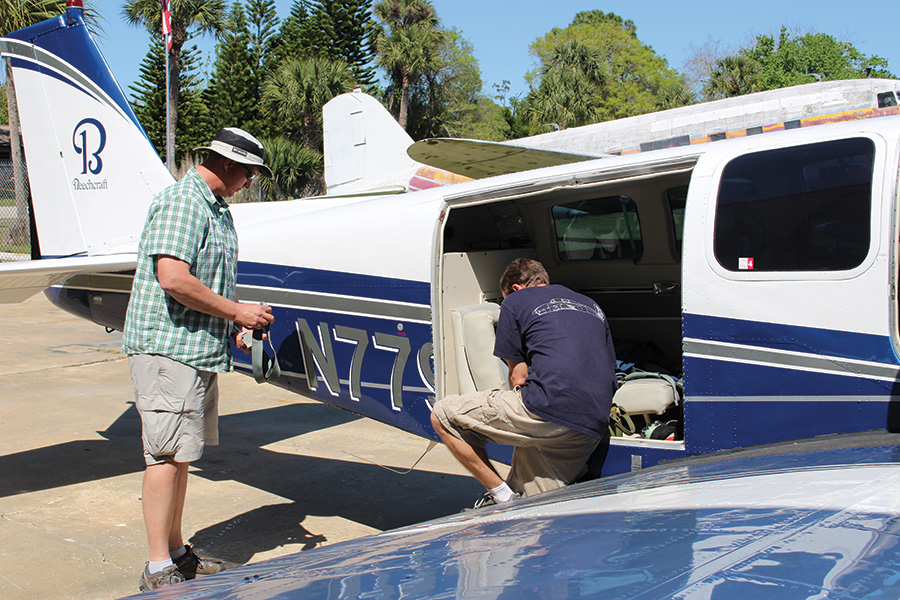
While chatting with VanderMeulen about the upcoming photo mission, Boulware removes the rear doors and most of the club seating from his faithful A-36 Bonanza.
Preflight
I notice VanderMeulen carefully checking every corner of the interior. He says he is looking for loose objects and dirt, then tells a funny story about renting a dog-owner’s Bonanza and spending hours vacuuming, rather than suffer a dog hair storm on takeoff. He also tells about getting some aluminum drill swarf blown into his eye, which was not so funny.
The seat rails and supports remain bolted in the airplane. We’ll use them as safety harness anchors. VanderMeulen, the professional, has a real harness, custom made for him by a parachute manufacturer, and he adjusts his anchor strap so he can’t quite fall out the open door. I don a climber’s seat harness, a relic from former adventures. I am advised that photographers have been known to slip out of them, so I pull it real tight and clip into an anchor well away from the door.

VanderMeulen has learned from experience that it pays to check every corner of the interior for loose objects and dirt.
VanderMeulen’s harness incorporates a back pad. That’s because hardware (like exposed seat rails) will jab and poke without mercy, not to mention tearing your pants or performing an ad hoc vasectomy. Such concerns are valid, because so far, the wind has not abated very much, and we’re starting to wonder if it might be a wee bit bumpy up there.
Eventually we strap in and Boulware fires up the mighty Continental. He shuts it down again when VanderMeulen notices the hat shelf flopping in the propwash aft of the open door. A few feet of tape cures the problem, and we head for the runway.
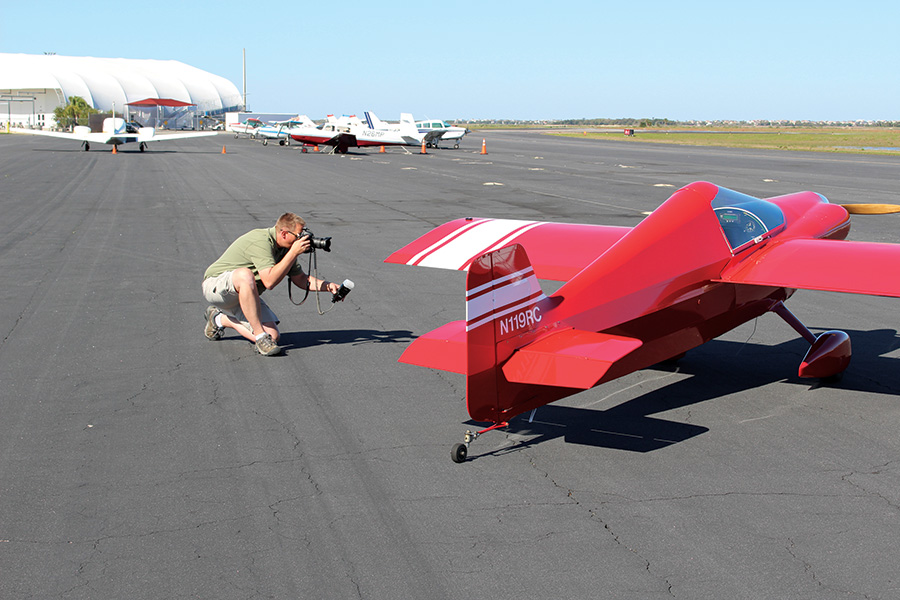
VanderMeulen works on static shots of Berry’s Cassutt, gathering frame after frame from every imaginable angle.
To St. Augustine
Our destination is St. Augustine, 58 miles up the coast, where we’ll meet our photo subject. As soon as we’re off the ground, VanderMeulen grabs each of his cameras and fires off a few. Experience again; no point in burning gas only to find a problem later. It’s windy in the back, but not any more than expected. However, fifteen minutes into the leg, the AA batteries in my Lightspeed Zulu2’s crap out, and I learn that the open door generates a low pitch harmonic boom strong enough to rattle eardrums. Naturally, my spare batteries are back in the RV-8.
Up front, Boulware hunts for a smooth altitude. He finds none, but we cross our fingers and tell each other it will calm when the sun gets low. Still plenty of time; the evening’s “golden hour” of perfect light is still more than three hours distant. There is not a cloud in the sky.
In due course Boulware greases Runway 31 at St. Augustine. We can hear the Cassutt we’ve come to photograph calling the tower from the other direction. Pilot Patrick Berry amuses everyone when a grouchy tower controller orders a premature turn during rollout. Berry ignores him, and then responds (quite rightly) with, “Sorry, I was busy flying the airplane.”
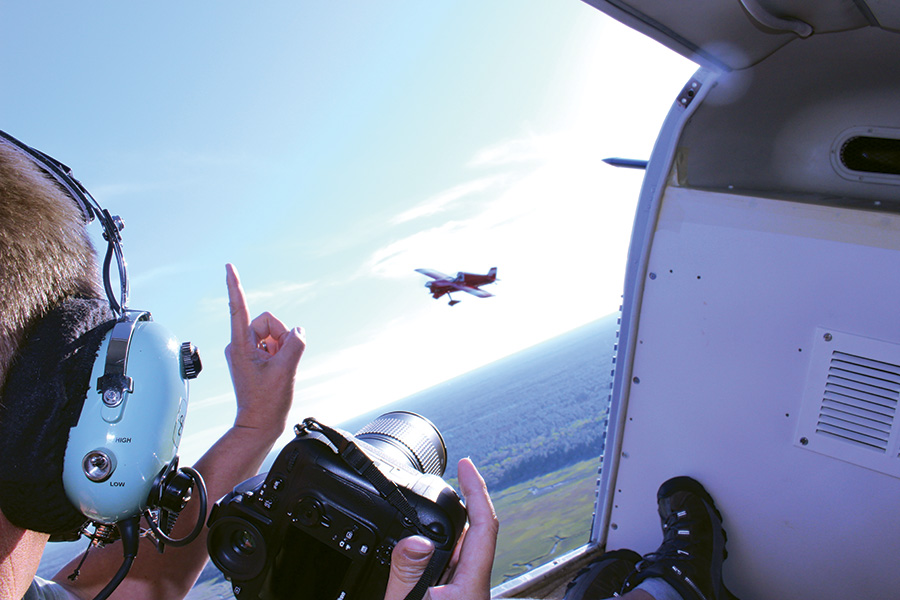
Using hand signals and the radio, VanderMeulen directs Berry to move upward, forward, backward, and down, each in turn.
Ground Shots and Briefing
The Cassutt is an eye-popping ripe-tomato red, and very well finished. After introductions, VanderMeulen goes to work on static shots, gathering frame after frame from every imaginable angle. We all watch awhile, then I borrow the FBO courtesy car to fetch new headset batteries. The others find shade, and like pilots everywhere, start telling stories.

VanderMeulen uses a harness custom made for him by a parachute manufacturer. He adjusts his anchor strap so he can’t quite fall out the open door.
The golden hour draws near. With thirty minutes until liftoff, VanderMeulen calls us together for a briefing. We discuss frequencies, break procedures, expected maneuvers, hand signals, and a host of other items. It’s a refresher for the photo plane crew, but new to Berry, and he is looking very serious. Each participant has a specific job. Boulware will mind the Bonanza and fly as directed by VanderMeulen. He will also be the communicator, handling ATC issues and relaying instructions to Berry in the Cassutt when necessary. Safety pilot Fred Vyfvinkel will be the eyes of the group, responsible for traffic spotting, buzzard avoidance, and backing Boulware. Berry will place the Cassutt where needed, working from hand signals and the radio. I will shut up and stay out of the way.
The Mission Begins
Everybody climbs aboard and we taxi out. Grumpy is still in the tower and needles Berry, pointedly canceling a taxi clearance before answering a request for clarification. Eventually we line up on 31 and launch to the north.
Boulware doesn’t climb far. It’s immediately apparent that the air has not calmed even a little bit. VanderMeulen says conditions are marginal, but the light is nearly perfect. We all hate to see the opportunity wasted, and agree to let Berry be the deciding factor. If he can safely hang in formation, we’ll proceed.
Light, Camera, Action
One hour before sunset over the Tolomato River salt marsh: Showtime. VanderMeulen starts Berry with gentle circles to the left. Circling means the sun angle is always changing, thus offering the photographer an infinite variety of lighting angles. A left turn puts Berry on the outside, generally more comfortable in difficult conditions. VanderMeulen doesn’t push, allowing Berry to work his way in closer as he settles down and gains confidence. Both airplanes are moving around a good bit, the Bonanza bouncing in the solid Beechcraft way, while the Cassutt looks more like a Duncan yo-yo in the open door. VanderMeulen braces his back on the spar carrythrough, presses his toes to the rear wall, and bobs the long lens up and down like a man in a rocking rowboat.
After 10 minutes or so, Boulware tightens the circle, and VanderMeulen begins directing Berry to move upward, forward, backward, and down, each in turn. Berry is clearly working hard, but seems fine, showing no distress in his flying or in his voice.
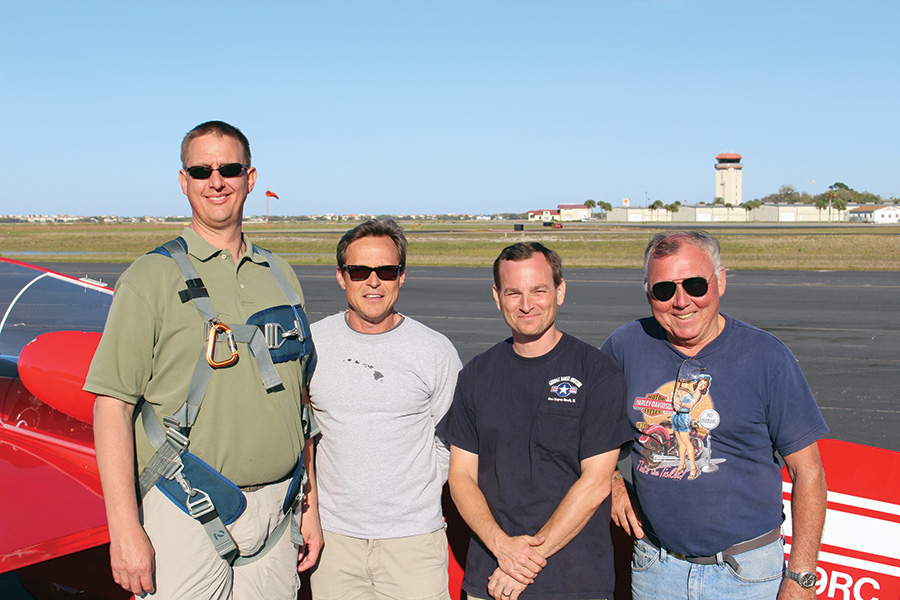
The Crew, left to right: photographer Richard VanderMeulen, Cassutt pilot Patrick Berry, Bonanza pilot Curtis Boulware, and safety pilot Fred Vyfvinkel.
The steep left turn and high position frames the Cassutt against the bare blue sky. A low shot places the airplane on the horizon, banked artfully toward the camera. VanderMeulen holds Berry in each position through one or more full circles, gathering images as the sun angle sweeps through a full 360 degrees. Eventually he declares a break, and Berry slides away some distance to unwind.
Moving Down
When we rejoin, Boulware starts a right turn to put Berry on the inside, upping the game for everyone. In addition to framing, focus, and light, VanderMeulen is now working to capture background, the whole point of the right turn. Boulware is being very conscious of altitude and position. To get detailed background we’re at 500 feet, and the subject is slightly lower. Drifting downward, or back toward civilization, is not an option. Even Vyfvinkel is under pressure. We’re at helicopter and bird level, and spotting is more difficult each time we circle west into the setting sun.
Conditions remain bumpy. In the Bonanza we’re not quite floating off the floor, but sometimes it gets close. Berry must be getting tired, although he isn’t showing it. Each time the gyrations get too radical, he slips aft a bit, takes a breath, and slides back in. VanderMeulen eyeballs the pines, marsh grass, and open water, directs Boulware to sweep past a few specific backgrounds, then declares another break.
With the standard shots in the bag, we move out to the beach, rejoin, and fly low, gentle circles. VanderMeulen studies the sun and the sea. The shooting seems both random and carefully planned, much as a seasoned gambler plays the cards he is dealt. The gambler appreciates luck, but never expects it. VanderMeulen works hard for his luck.
The winds are finally dying, and the light is gentle. We relax and enjoy the flight, until we have no more time. Berry is based at Fernandina Beach. The Cassutt has no lights, and he has 30 miles to go before sundown. He rolls for a last pull, and we turn for home.

